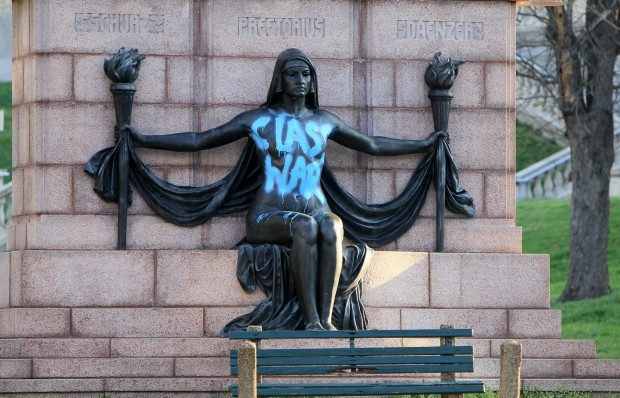Part 2: The Untold History of St. Louis Monuments
Landmarks Association of St. Louis
The statue “Naked Truth” vandalized in Compton Hill Reservoir Park
Many who call St. Louis home have experienced the thrill of sledding down Art Hill in Forest Park on a snowy winter day, or admiring the sights of the Botanical Gardens on a refreshing spring afternoon.
However, few of the sledders on Art Hill would guess that the statue above them represents white supremacy to someone, or that the flourishing grounds of the Botanical Gardens were paved by slaves.
Last chapter we looked at the basic facts of a few famous monuments in St. Louis. Now, through digging a little deeper into the untold history of St. Louis monuments, we can examine the prosperity and growth of our city, as well as its faults and immorality in the past, by finding out the untold truth.
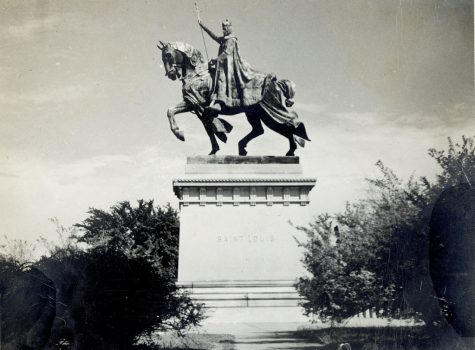
Apotheosis of St. Louis
The Apotheosis of St. Louis is a pinnacle monument of our city, and portrays a symbol of our community in a prominent and well known location in front of the Art Museum in Forest Park.
Despite the fact that King Louis IX is a key figure in the portrayal of our city, the history behind his powerful position is different than what first meets the eye. King Louis IX was known as a just and intelligent ruler, though according to journalist Mic Anderson, “His sincere piety did not prevent him from curbing the abuses of the clergy, sometimes brutally.”
In the summer months of 2020, there were protests in Forest Park in front of the statue, protesting for it to be taken down, and CHS Junior Ruby Nadin witnessed it.
“I was on art hill with my friends, and we were looking over at the Art Museum, and there were a bunch of people standing around the statue,” said Nadin. “Some of them had signs, and there was one guy who was the main speaker.”
Some of the protesters believed that this statue symbolizes white supremacy. The St. Louis Post Dispatch who reported on the issue the summer that it happened interviewed a protester. The protestor Umar Lee stated, “He’s gonna come down… This guy right here represents hate and we’re trying to create a city of love. We’re trying to create a city where Black lives matter. We’re trying to create a city where there is no antisemitism or Islamophobia … this is not a symbol of our city in 2020.”
The opposing groups protesting for the statue to stay had more religiously based reasoning. Maria Miloscia of Jefferson County, protesting to keep the statue upright, said The St. Louis Post Dispatch, “ ‘I think he symbolizes deep faith and convictions. I stand for him. And I stand for those Catholic virtues and those Catholic values that I think are important, like courage, faith and love. But ultimately, I’m here for Christ the king.’ ”
While Nadin saw the protest happening, she and her friends didn’t entirely know what was going on.
According to Nadin, “I only knew it was even a protest because some woman told [me and my friends] that it was a protest. The woman who I talked to said it should stay, because it was religiously important.”
The woman involved told Ruby and her friends that removing the statue went against the ideals of the religion connected to Louis IX.
According to Dr. Daniel Glossenger, economics and history teacher at CHS, “I think that both sides of the protest at that statue don’t want us to ignore the past, and they don’t want us to just tell one story. I think both sides would agree that the past is complex.”
This statue, though sparking conflict, is not as controversial as others, such as the Columbus statue that was taken down in Tower Grove in 2020 after protests.
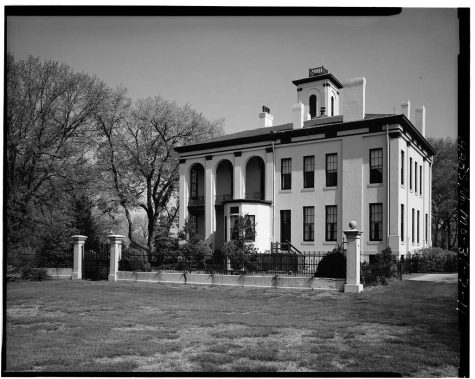
Henry Shaw House & The Botanical Gardens
Henry Shaw’s house, examined in the previous chapter, is a landmark of St. Louis. It’s architecture from the time period makes it a beautiful place to visit at the Botanical Gardens. However, some people don’t know that from 1826 to 1860, Henry Shaw, the park’s founder, acquired around 8-11 slaves and domestic servants in his time working at the Botanical Gardens.
In June 2020, the Missouri Botanical Garden shared a Facebook post with a few of the names of Shaw’s slaves: Juliette, Peach, Jim, Sarah, Bridgette, Joseph, Tabitha and her daughter Sarah, Ester and her children, among others.
Missouri Botanical Garden stated that, “In 1855, four of Shaw’s slaves escaped but were caught as they crossed the Mississippi River. Esther and her children were trying to get to the free state of Illinois where they hoped to connect with helpers to travel further north on the Underground Railroad. Shaw consequently sold Esther south to Vicksburg, Mississippi, separating her from her children.”
By the 1850s, when Shaw was building his house in Tower Grove and buying farm land slavery was on its way out of the city. Slavery wasn’t unusual, but it wasn’t the norm. There was also an increasing population of free black people in St. Louis. Shaw also practiced leasing out his slaves by hiring out certain slaves and hiring in domestic servants.
Though Shaw was known to botanists, businessmen, and the people of St. Louis as a brilliant creator, there is untold history behind the walls of the statues, plants, and architecture of his gardens.
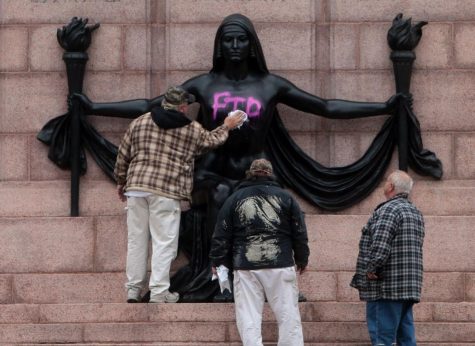
The Naked Truth
The Naked truth statue, located in The Compton Hill Reservoir Park, is inevitably controversial, in not just the message behind the statue, but also how it’s viewed. As a German-American memorial, celebrating the alliance of the Germans and the Americans during the Civil War, and an 8’x 20’x 15’ depiction of a naked woman: this statue has a long history of controversy.
“One of the reasons that it was controversial when it was unveiled is that it’s a naked female form, and that was offensive to the Victorian era of cultural norms in the United States about policing women’s bodies, and I think that statue garnered a lot of attention for that reason,” said Glossenger, “It was also controversial due to the fact that it celebrated Germans in America, and their contributions to the United States at the very time when the U.S. started to go to war with Germany.”
Less than two months after The Naked Truth was put up, World War 1 began and
Germany became an enemy to the U.S. According to The Landmarks Association of St. Louis, in 2012, “The nearly century-old monument was defaced with blue spray paint reading, ‘Class War.’ The vandalism was not contained to only the statue. Spray painted messages also appeared on the west wall of the reservoir and the adjacent comfort station.”
During an anti-police protest in November, 2014, the statue was vandalized once again with the spray painted letters of “FTP”, regarding the anti-police protests happening all around the city, state and country at the time. This statue is no stranger to controversial opinions and offenses of vandalism.
Through its more than 106 years of existence, this monument has undergone many restorations, and may continue to in the future. The German-American history in St. Louis is complicated, but through the hardships this city has had to face in the past, St. Louis has learned to live through it, and move forward into the future.
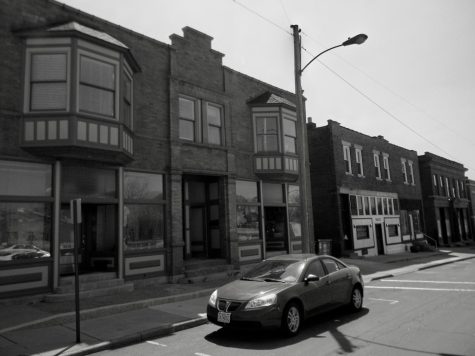
MLK statue
The Martin Luther King Jr. statue located in Fountain park is a great symbol of racial equality progression in St. Louis.
In the mid 1800s, Fountain Park was developed as a middle-class suburb, on the edge of Central West End. As a largely black populated neighborhood, racially restrictive housing was a very common thing in St. Louis at the time. Despite the fact that the Supreme Court ruling of Shelly vs Kraemer struck down racially restrictive housing covenants in 1948, housing segregation still exists today in the neighborhoods of St. Louis.
The legal sense of the “structural barriers” that have been taken down regarding the racism in black neighborhoods in St. Louis is what is most commonly looked at when examining the status we’re at now in history. But, racism never left the black neighborhoods of St. Louis after the ruling of Shelly v Kraemer.
Looking into the impact on the history of the statue in the neighborhood today, Glossenger stated, “[The Martin Luther King statue] also shows the progress that we still need to make, because if you visit that statue, and you visit Fountain park, you’ll see the disinvestment in that community. That there aren’t the jobs available for people, to pay good middle class wages, and the movement of jobs out of our city centers, along with the discrimination that people that live in that neighborhood face, I think is another exhibit of the progress that we still need to make, in terms of economic justice.”
To conclude:
Through these past two issues, we’ve learned that the darker and unexpected history of St. Louis can’t be changed, but it can be understood and acknowledged. In the past few decades, we’ve done a more progressive job as a city in recognizing our past faults. And as for the future– not everything can be predicted or assumed, but with progress and growth comes change.
A $50 or more donation includes a subscription to the Clayton High School Globe 2024-2025 print news magazine.
We will mail a copy of our issues to the recipients of your choice.
Your donation helps preserve the tangible experience of print journalism, ensuring that student voices reach our community and that student democracy thrives.

Pronouns: she/her
Grade: 12
Years on staff: 4
What's an interesting fact about you? I am co-president of the Speech and debate team, the Senior Class Vice President, and...


